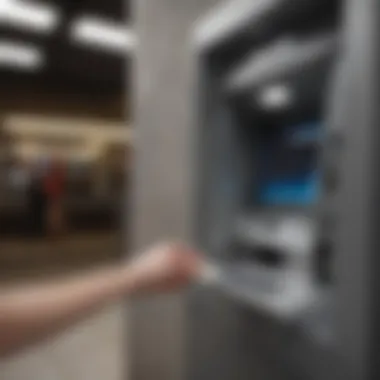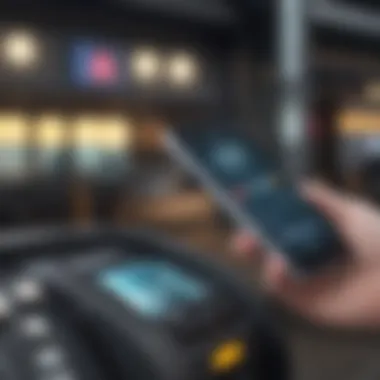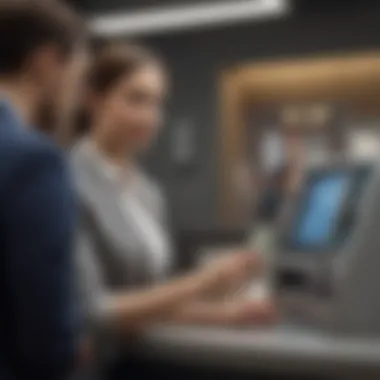How to Add Funds to Your ATM Card Effectively


Intro
Setting Financial Goals
Importance of Setting Goals
Setting financial goals helps individuals focus their efforts and resources. Clear objectives provide direction and motivation. When you know what you want to achieve, be it saving for a vacation or paying off debt, it becomes easier to stay accountable and track your progress.
How to Establish Realistic Financial Objectives
Realistic financial objectives are specific and measurable. You should start by assessing your income and essential expenses. Determine what amount you can allocate towards your savings or paying off debts. Setting short-term and long-term goals can also be beneficial. For example, a short-term goal could be saving $500 within three months while a long-term goal might involve saving for a house deposit.
Tracking Progress and Adjusting Goals
Regularly monitoring your financial progress is essential. Utilize budgeting tools or apps to help visualize your savings and track expenses. If you find you are falling behind, do not hesitate to re-evaluate your goals. Adjustments can be made as necessary but maintaining the overall aim is critical.
Budgeting and Expense Management
Creating a Personal Budget
A well-structured budget serves as the backbone of effective financial management. Start by listing all sources of income and monthly expenses. Categorize your expenses into fixed costs, such as rent, and variable costs, like groceries and entertainment. This categorization helps in identifying areas where you might cut back.
Tips for Cutting Costs and Saving Money
Small changes can lead to significant savings over time. Consider reviewing subscription services to eliminate ones you don’t use. Cooking at home instead of dining out is another effective way to save money. Implementing a no-spend challenge can also help focus your spending habits.
Tools and Apps for Tracking Expenses
There are numerous budgeting tools available today, such as Mint and YNAB. These platforms often come with user-friendly interfaces, allowing you to sync bank accounts and keep track of expenditures easily. Regular usage of these tools can yield insights into your spending patterns and help maintain financial discipline.
Saving and Investing
Building an Emergency Fund
An emergency fund is critical for financial stability. Aim to save enough to cover three to six months' worth of expenses. This fund can provide a safety net in unexpected situations, reducing reliance on credit cards and loans.
Types of Investment Options (Stocks, Bonds, ETFs, etc.)
Investing can be an effective method to grow wealth. Stocks offer potential high returns, while bonds generally provide stability and steady income. Exchange-Traded Funds (ETFs) simulate a stock index and diversify investments without needing to buy individual stocks.
Strategies for Diversifying Your Portfolio
Diversification reduces risk in investment portfolios. Allocate funds across different asset classes, sectors, and geographic regions. Consider both long-term and short-term investments for a balanced approach that aligns with your risk tolerance.
Debt Management
Understanding Different Types of Debt
Debt can take various forms, such as credit cards, student loans, or mortgages. Each comes with its own terms, interest rates, and repayment schedules. Understanding these differences is essential for managing them effectively.
Developing a Repayment Plan
Create a repayment strategy that prioritizes high-interest debts first. The snowball method, which focuses on paying smallest debts first, can also be motivational. Stay committed to your plan, and regularly review it to assess your progress.
Consolidation and Refinancing Options
If managing multiple debts becomes overwhelming, consider consolidation or refinancing. These processes can simplify payments and potentially lower interest rates. Research local credit unions or financial institutions that offer favorable terms.
Retirement Planning
Importance of Early Retirement Planning
Starting early with retirement planning lets compound interest work in your favor. The earlier you save, the more you accumulate over time, which can lead to a more comfortable retirement.
Different Retirement Accounts ((k), IRA, etc.)
Familiarize yourself with various retirement accounts. A 401(k) is employer-sponsored and often includes matching contributions, while an Individual Retirement Account (IRA) offers tax advantages for individual contributions. Understand the pros and cons of each to maximize your savings strategy.
Maximizing Retirement Savings with Employer Matching Contributions
If available, take full advantage of employer matching contributions. This money is essentially 'free' toward your retirement. Contribute enough to your 401(k) to meet this match, as it is an invaluable way to enhance your retirement savings.


Understanding and managing financial aspects of our lives is an ongoing journey. The insights gained through sound financial practices not only empower individuals but also contribute significantly to personal well-being.
Understanding ATM Cards
Understanding ATM cards is vital for anyone looking to manage their finances efficiently. ATM cards provide a gateway to accessing cash, making payments, and managing funds effectively. In today’s digital age, they are not just a convenience but a crucial tool in personal finance management. Knowing how to use these cards properly enhances one’s ability to control spending and access funds when necessary, contributing to financial literacy.
Definition of ATM Cards
ATM cards are banking tools issued by financial institutions. They allow users to withdraw cash and perform transactions at automated teller machines. Generally, ATM cards are linked to the holder’s bank account, enabling direct access to the funds available in that account. These cards can also take various forms, often tailored to particular financial needs, whether for everyday shopping, travel, or general cash access.
Types of ATM Cards
Understanding the different types of ATM cards is essential for users, as each serves unique purposes and offers distinct advantages.
Debit Cards
Debit cards represent a direct link to an individual's bank account. The convenience of debit cards lies in their ability to allow users to make purchases up to the amount available, eliminating the risk of overspending. An important feature is their widespread acceptance at most retail outlets and online platforms. The primary characteristic of debit cards is that they require no credit check, making them an accessible option for many. However, users must monitor their account balances to avoid overdrafts, as funds are drawn directly from their bank accounts immediately after a transaction.
Prepaid Cards
Prepaid cards function similarly to debit cards but are preloaded with a specific amount of money. This feature makes prepaid cards beneficial for individuals who want to manage their spending strictly. They are particularly useful for budgeting purposes. Users can reload or add money to their prepaid cards as needed. One downside is that they might not offer the same level of consumer protection or rewards as debit or credit cards. Moreover, prepaid cards can sometimes have fees associated with reloading or maintaining the account, which users should be aware of.
Credit Cards with ATM Access
Credit cards with ATM access allow users to withdraw cash up to a predetermined limit, known as the cash advance limit. This feature is beneficial in emergencies when cash is needed urgently. Although it offers convenience, using credit cards at ATMs comes with high-interest rates and fees that users need to consider. Another characteristic is that these transactions can impact the available credit limit affecting future purchases. Therefore, while they offer a temporary solution, they may not be the most cost-effective option for regular cash withdrawals.
Why Add Money to an ATM Card
Adding money to an ATM card is a key aspect of using this financial tool effectively. It offers several benefits that can enhance your banking experience. Understanding these benefits can help individuals make informed decisions about their finances. This article delves into three main reasons why adding funds to an ATM card is often a wise choice.
Enhanced Accessibility
Having money loaded on an ATM card allows for greater accessibility. Users have the freedom to withdraw cash whenever necessary. This convenience means that individuals do not need to visit a bank branch during working hours to manage their funds. With an ATM card, one can access funds in various locations and at any time.
Additionally, this improved accessibility also enables immediate transactions. Whether it is for personal use or emergencies, having cash readily available can be crucial. Many ATMs are in close proximity to shopping areas, business districts, and travel hubs. This ease of access can significantly reduce the time it takes to obtain cash when it is needed.
Improved Financial Management
Loading money onto an ATM card aids in personal financial management. It can help individuals budget their expenditures effectively. When cash is deposited onto the card, it provides a clear view of available funds. This visibility helps prevent overspending.
Using an ATM card also can facilitate saving. For instance, people can set aside a certain amount to be accessed later. This can encourage better saving habits since users can withdraw cash only when necessary. Thus, an ATM card becomes not just a tool for spending, but also a means of tracking and managing finances with greater precision.
Facilitated Transactions
Adding funds to an ATM card allows for a seamless payment process. Users can easily make payments at participating merchants. Many businesses accept ATM cards directly, which eliminates the need for cash or checks during transactions.
Moreover, this capability can speed up e-commerce purchases. Individuals can input their card details to pay for goods and services without needing to transfer funds from a bank account each time.
"The convenience of an ATM card simplifies financial transactions for consumers, making everyday purchases more manageable."
Methods to Add Money to an ATM Card
Adding funds to an ATM card is not just a matter of convenience; it is essential for managing your finances effectively. There are several methods available for depositing money, each with its own benefits and considerations. Understanding these methods can empower users to choose options that align with their financial goals and lifestyle. The methods discussed will cover cash deposits, direct bank transfers, mobile banking applications, and money order deposits. This knowledge equips users with the necessary tools to enhance their financial management.
Cash Deposits via ATMs
Cash deposits through ATMs provide a direct and fast means to add money to an ATM card. This method allows users to deposit cash without needing to interact with bank personnel, which can be a significant time saver.
Identification Requirements
Identification is a critical aspect of using ATMs for cash deposits. Typically, users need to insert their ATM card and enter a PIN to authenticate the transaction. This requirement enhances security by ensuring that only the card owner can access their funds.
The key characteristic of identification requirements is simplicity. Users do not need to show physical identification, which reduces waiting times, making it a beneficial choice. However, it can present a disadvantage for those who forget their PIN.
Step-by-Step Process
The step-by-step process of cash deposits is straightforward and user-friendly. After inserting the ATM card, follow prompts on the screen, select the deposit option, and insert cash into the designated slot. This method is beneficial as it is fast and minimizes human error. Users might find it easier compared to dealing with bank staff.
Nonetheless, it can sometimes be confusing for first-time users. Providing clearer instructions at ATMs could enhance the experience further.
Transaction Limits
Transaction limits are an important factor to consider when making cash deposits. Most banks impose a limit on the amount of cash that can be deposited in a single transaction or within a 24-hour period. This is crucial for managing security risks and preventing money laundering.


The limitation can be beneficial since it ensures safer operations, but it can also be limiting for users needing to deposit large sums quickly. It is advised to check with your bank to understand these limits before proceeding.
Direct Bank Transfers
Direct bank transfers serve as another convenient method for adding funds to an ATM card. This method involves linking a bank account directly to the ATM card for easy sliding of funds.
Linking Bank Accounts
Linking bank accounts is a relatively simple process that allows users to effortlessly transfer money. This usually involves providing bank account details and verifying them through a security process.
The key characteristic here is ease of use. Once linked, transferring money is as easy as a few taps on a mobile application or online banking platform. It promotes financial efficiency. However, users may face challenges if they need to link multiple accounts to different ATM cards.
Transfer Limits and Fees
Understanding transfer limits and any associated fees is significant. Banks often place restrictions on the amount of money that can be transferred at once or daily. Fees may also apply, particularly for instant transfers.
This limits ensure user protection and allow banks to manage operations effectively. However, it can deter users who need to transfer larger amounts without incurring additional costs. It is wise to review terms with your bank beforehand.
Mobile Banking Applications
Utilizing mobile banking applications provides a modern, tech-savvy solution for funding your ATM card. This method allows transfers from anywhere, making banking very convenient for users.
Setup Instructions
Setting up mobile banking is typically straightforward. Users should download the appropriate app from their bank and follow the on-screen prompts to create an account. This method is attractive because it supports various functionalities beyond just depositing money. Users can view statements, pay bills, and more.
However, while setting up can save time, it requires a level of tech proficiency and internet access, which may not be accessible for everyone.
Using Third-Party Services
In addition to direct bank apps, there are numerous third-party services that facilitate money transfers. This could include platforms like PayPal or Venmo, which offer user-friendly interfaces for mobile transactions.
The ease of using third-party services can appeal to tech-savvy users. Users can conveniently send money between accounts without restrictions. However, third-party services may charge fees and require linking to a bank account.
Security Considerations
Given the digital nature of mobile transactions, security considerations are paramount. Ensuring the use of secure connections and employing complex passwords helps prevent unauthorized access.
The focus on security mitigates risks, but it may complicate transactions for users unfamiliar with technology. Educating users on best practices can make a difference.
Money Order Deposits
Money orders provide an alternative method for adding money to an ATM card. Unlike checks, they are prepaid, which can enhance security when depositing funds.
Where to Purchase Money Orders
Money orders can be purchased at various locations, including banks, post offices, and retail grocery stores. Finding a convenient location is usually easy. This characteristic makes money orders a popular choice for many users.
However, users must inquire about service fees at each location, as costs can differ. In addition, not every retailer may issue large money orders, and that could limit the amount that can be deposited at once.
How to Deposit Them via ATM
Depositing money orders through an ATM involves some basic steps. The user must follow ATM prompts, usually selecting the deposit option and inserting the money order into the deposit slot.
The unique feature of this option is the ability to deposit cashless with some assurance against bounced checks. Yet, this option can slow down the deposit process, as machines may take longer to process paper forms than cash.
Understanding these methods ensures that users can maintain their ATM cards effectively, thereby enhancing their financial management capabilities.
Security Considerations
In a world increasingly dependent on electronic transactions, ensuring the security of one’s ATM card is paramount. This section addresses various aspects of security which are crucial when adding money to an ATM card. Understanding these considerations can prevent financial losses and protect personal information.
Protecting Personal Information
When using an ATM, it is vital to protect your personal information. Personal data can be vulnerable to theft through different methods. Always shield your PIN when entering it at the ATM. Cover the keypad with your other hand to prevent anyone from seeing it.
Another step is to ensure that the ATM is located in a well-lit and secure area. Using ATMs in busy locations can reduce the risk of theft. Be cautious of any suspicious individuals nearby. Also, review your bank statements regularly to identify any unauthorized transactions promptly.
Implementing identity theft protection services can also be beneficial. These services monitor your credit report and alert you to any suspicious activities. Keeping your contact information updated with your bank allows them to contact you immediately in case of any detected irregularities.
Recognizing Fraudulent Transactions
Fraudulent transactions can occur without warning. Learning to recognize signs of these transactions is essential. If you notice unfamiliar withdrawals or transfers from your account, investigate them immediately. You can usually report these discrepancies to your bank to halt further transactions.


Common signs of fraud include:
- Unexpected withdrawals: Transactions you do not recognize can indicate unauthorized access.
- ATM error messages: If an ATM gives an error message that seems suspicious or doesn’t match typical issues, it’s prudent to check your account balance later.
- Unusual account activity: Frequent, small withdrawals can sometimes indicate a scam.
If you suspect any fraudulent activity, contact your bank immediately. Quick action can help to minimize potential damage.
Best Practices for Safe Transactions
To ensure safe transactions, adopting best practices is necessary. Begin with only using ATMs from reputable institutions. Major bank ATMs are generally more secure than those from random locations.
Here is a list of additional best practices:
- Verify ATM's security features: Check for any unusual attachments on the ATM that could indicate it has been tampered with.
- Avoid sharing personal information: Never give your PIN or other personal details to anyone, including bank representatives who may contact you.
- Use two-factor authentication: If your bank provides additional security measures, such as two-factor authentication for your online banking account, activate them.
- Logout of your account: If you access your account using online methods or apps, ensure you log out after your session.
By adhering to these best practices, individuals can significantly lower their risk of falling victim to ATM fraud and identity theft.
Common Issues and Solutions
In the process of adding money to an ATM card, consumers may encounter various challenges. Identifying and resolving these issues is essential to ensure a smooth transaction experience. Addressing common problems not only saves time but also helps individuals enhance their financial management skills. This section outlines two main categories of troubles: failed transactions and ATM malfunctions. Understanding these categories facilitates better handling of situations, increasing user confidence.
Failed Transactions
Understanding the Causes
Failed transactions can occur due to various reasons. These include insufficient funds in the account, wrong data entry, or network issues. Each cause represents a unique challenge and can disrupt planned financial activities. Knowing these causes is crucial as it prepares users to prevent them in the future. For instance, always ensuring sufficient balance before attempting to deposit can reduce frustration. More awareness on this topic is a beneficial element of managing ATM cards effectively.
Troubleshooting Steps
When a transaction fails, knowing how to troubleshoot the issue is key. First, check for any error message displayed on the ATM screen. This message can often indicate the cause of failure. If the issue persists, checking online banking or calling customer support can provide assistance. These troubleshooting steps are necessary because they guide users in resolving issues independently. Implementing effective troubleshooting methods can lead to quick solutions, minimizing inconvenience during banking operations.
ATM Malfunctions
Identifying Malfunctions
ATM malfunctions can disrupt access to funds. Common signs of malfunction include a non-responsive screen, machines not accepting cards, or difficulties in dispensing cash. Recognizing these signs is vital since it helps users determine when to contact support. Being knowledgeable about malfunctions increases user comfort when using ATMs. Although this understanding does not control the machine’s behavior, it instills a sense of readiness to handle the unexpected.
Contacting Support
In instances of malfunction, prompt support contact is essential. Most ATMs display a phone number for support, which users can call to report issues. Effective communication with support services can lead to quick resolutions, ensuring users maintain access to their finances. Additionally, having support resources readily accessible reduces stress during unexpected situations. Understanding when and how to contact support is an important skill, fostering a reliance on expert assistance when needed.
Remember, being informed about common issues and knowing how to resolve them can significantly enhance your experience with ATM transactions.
Future Developments in ATM Technology
The landscape of ATM technology is evolving rapidly. This section delves into how future developments will greatly impact the functionality and accessibility of ATM cards. With innovation driving this sector, understanding these changes allows users to leverage enhanced features for their financial management. Moreover, it highlights the shift towards more seamless transactions, catering to the needs of a digital-age consumer.
Integration of Digital Wallets
The integration of digital wallets into ATMs is not just a trend, but a significant shift in how people manage their finances. Digital wallets such as Apple Pay and Google Pay enable users to store payment information securely. This allows ATM transactions without needing physical cards, improving convenience.
Benefits of this integration include:
- Enhanced Security: Digital wallets often provide encryption and tokenization, reducing the risk of card skimming.
- Faster Transactions: Users can avoid manual input of card details, which speeds up the process.
- Broader Accessibility: Digital wallets make it easier for individuals without traditional bank accounts to participate in financial activities.
As digital wallets become more prevalent, users can expect a smoother experience while withdrawing cash or checking account balances.
Evolution of Contactless Transactions
Contactless ATM transactions are becoming increasingly common. This technology allows users to simply tap their cards or smartphones on the ATM reader to execute transactions.
Considerations for the evolution of contactless transactions include:
- User Preferences: The demand for rapid, touchless interactions is on the rise, especially in a post-pandemic world.
- Increased User Base: As more customers, including those who prefer technology-driven solutions, gravitate towards contactless options, it encourages banks to adopt this technology.
- Efficiency and Convenience: With the simplicity of tapping instead of inserting cards, user experience improves significantly.
In summary, the future developments in ATM technology, including the integration of digital wallets and the evolution of contactless transactions, are pivotal. They promise to reshape how individuals manage and interact with their finances, providing greater convenience, security, and efficiency.
Culmination
In this article, we explored the intricacies of putting money into an ATM card. Understanding the methods and significance of these transactions is invaluable in today's financial landscape. Having the ability to fund your ATM card with ease opens up a myriad of conveniences. It not only enhances financial accessibility but also promotes better money management practices.
Summary of Key Points
- Methods of Funding: The various ways to add funds—like cash deposits, bank transfers, mobile apps, and money orders—make it adaptable to individual needs.
- Security: Protecting your personal information is paramount, especially with the increase of sleeker technology.
- Future of ATM Technology: Innovations such as digital wallets and contactless transactions are changing how we interact with our finances.
"Mastering the use of your ATM card can significantly ease day-to-day banking, making it a crucial skill in modern financial literacy."
Encouragement for Informed Use
As you navigate the realm of ATM card transactions, it is essential to be well-informed. Ensure that you explore all available methods to add money effectively. Understand the potential risks linked to each method and take precautions against fraud. Always keep track of your transactions, and don't hesitate to seek assistance if something seems amiss. Empower yourself with knowledge. This is key to successful money management.



